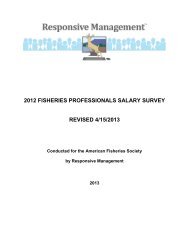Conservation Status of Crayfish Species Paddlefish Conservation ...
Conservation Status of Crayfish Species Paddlefish Conservation ...
Conservation Status of Crayfish Species Paddlefish Conservation ...
Create successful ePaper yourself
Turn your PDF publications into a flip-book with our unique Google optimized e-Paper software.
Tennessee-Kentucky, a 65,000-hectare reservoir<br />
on the lower Tennessee River; therefore,<br />
the dMA was particularly interested in<br />
any stock assessments <strong>of</strong> the Kentucky Lake<br />
population.<br />
When national attention began to focus<br />
on the Kentucky Lake fishery early in this<br />
century, little was known about the status <strong>of</strong><br />
paddlefish in the Tennessee River. University<br />
researchers had assessed the age structure, size<br />
structure, and commercial exploitation <strong>of</strong><br />
paddlefish in Kentucky Lake in the 1980s and<br />
early 1990s (H<strong>of</strong>fnagle and Timmons 1989;<br />
Timmons and Hughbanks 2000), but no fishery<br />
independent data were collected in those<br />
studies, and little information existed other<br />
than numbers <strong>of</strong> fish harvested in the years<br />
between 1999 and 2003. In the absence <strong>of</strong><br />
stock assessment data, the dMA is supposed<br />
to deny export permits, and some permits from<br />
Tennessee were denied in recent years (Marie<br />
Maltese; dMA; pers. comm.). It was clear<br />
to regulatory parties (i.e., dMA, Tennessee<br />
Wildlife Resources Agency [TWRA]) in 2001<br />
that a stock assessment should be conducted<br />
at the earliest opportunity.<br />
This article summarizes our stock assessment<br />
activities and the strategies we employed<br />
to convey our recommendations to the fishing<br />
industry, TWRA biologists, and the governing<br />
board <strong>of</strong> the TWRA, the Tennessee Wildlife<br />
Resources Commission (TWRC). We discuss<br />
what regulations were and were not enacted<br />
by the TWRC, and how a compromise was<br />
eventually reached to balance the state’s<br />
mandate to conserve fisheries resources with<br />
the legitimate economic interests <strong>of</strong> private<br />
businesses. Finally, we discuss what the future<br />
might hold for Tennessee paddlefish in light<br />
<strong>of</strong> recent harvest trends.<br />
StudY area and the<br />
COmmerCiaL FiSherY<br />
Kentucky Lake is the last impoundment<br />
on the Tennessee River before its confluence<br />
with the Ohio River (Figure 1). The lacustrine,<br />
downlake reach <strong>of</strong> the reservoir provides<br />
excellent habitat for paddlefish; whereas, the<br />
narrow, riverine headwaters serve as ideal fishing<br />
grounds for commercial fishers deploying<br />
gill nets during the winter and spring spawning<br />
migrations.<br />
Before 2002, fishers harvesting paddlefish<br />
were required to possess a commercial fishing<br />
license (US$125) and a free paddlefish<br />
permit. The season ran from 1 November<br />
through 23 April and there were no quotas<br />
or other harvest restrictions other than a 813mm<br />
eye-fork-length (EFL) minimum length<br />
Figure 1. Kentucky lake, a mainstream impoundment on the lower Tennessee River, is where most <strong>of</strong> the<br />
paddlefish harvested in Tennessee originate.<br />
when river conditions are right, paddlefish<br />
are easily harvested in the tennessee river,<br />
as demonstrated by Patsy Cornelius and deb<br />
blackwelder. Photo by Cory goldsworthy.<br />
Fisheries • vol 32 no 8 • august 2007 • www.fisheries.org 391







